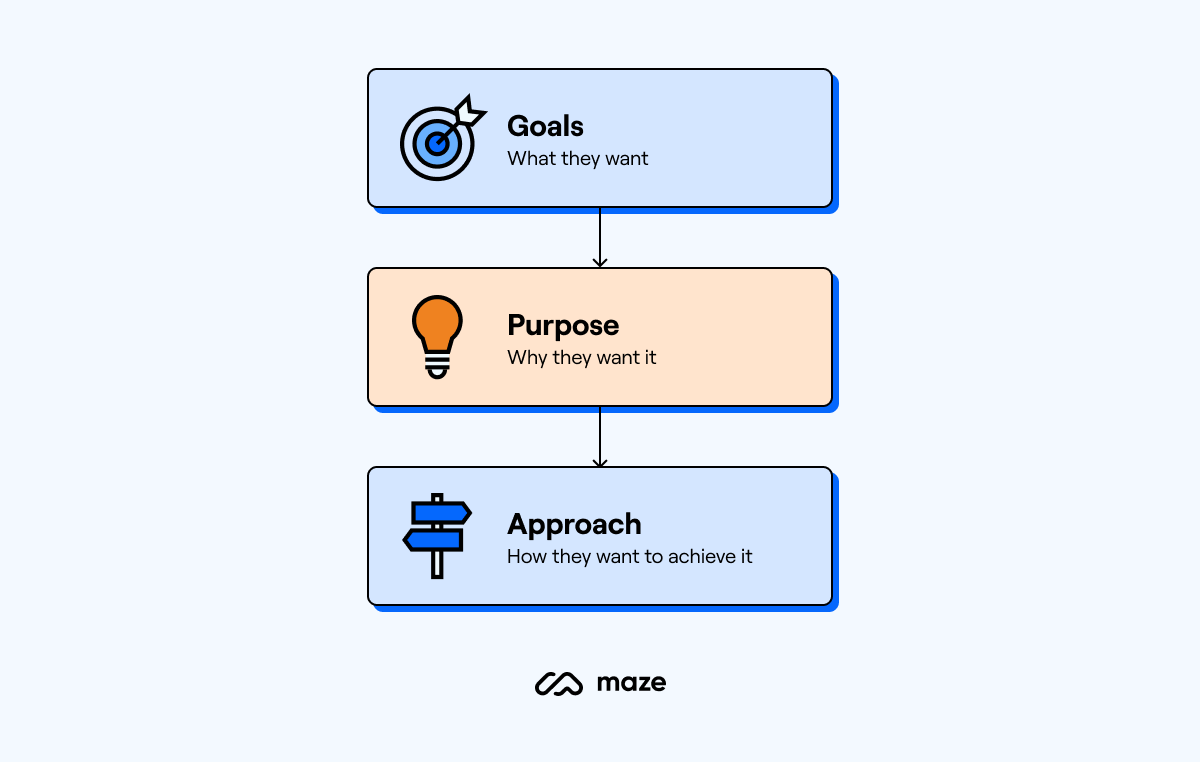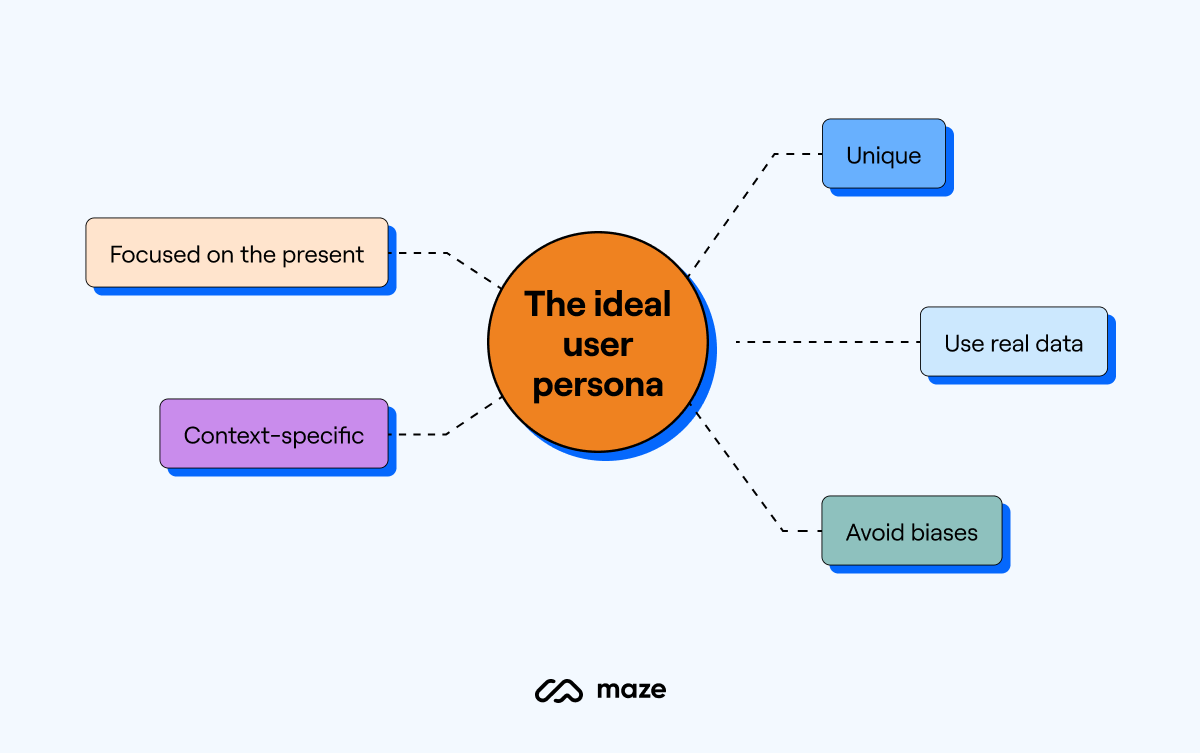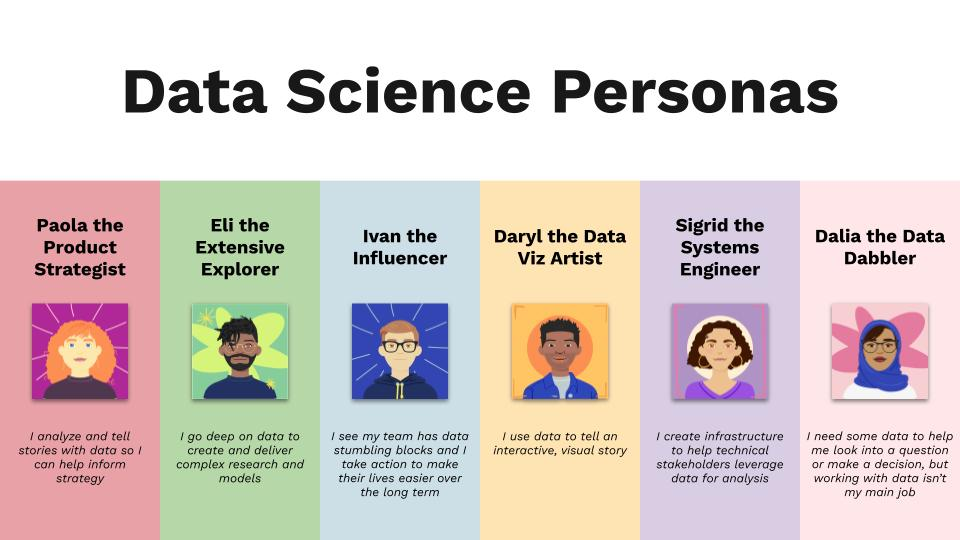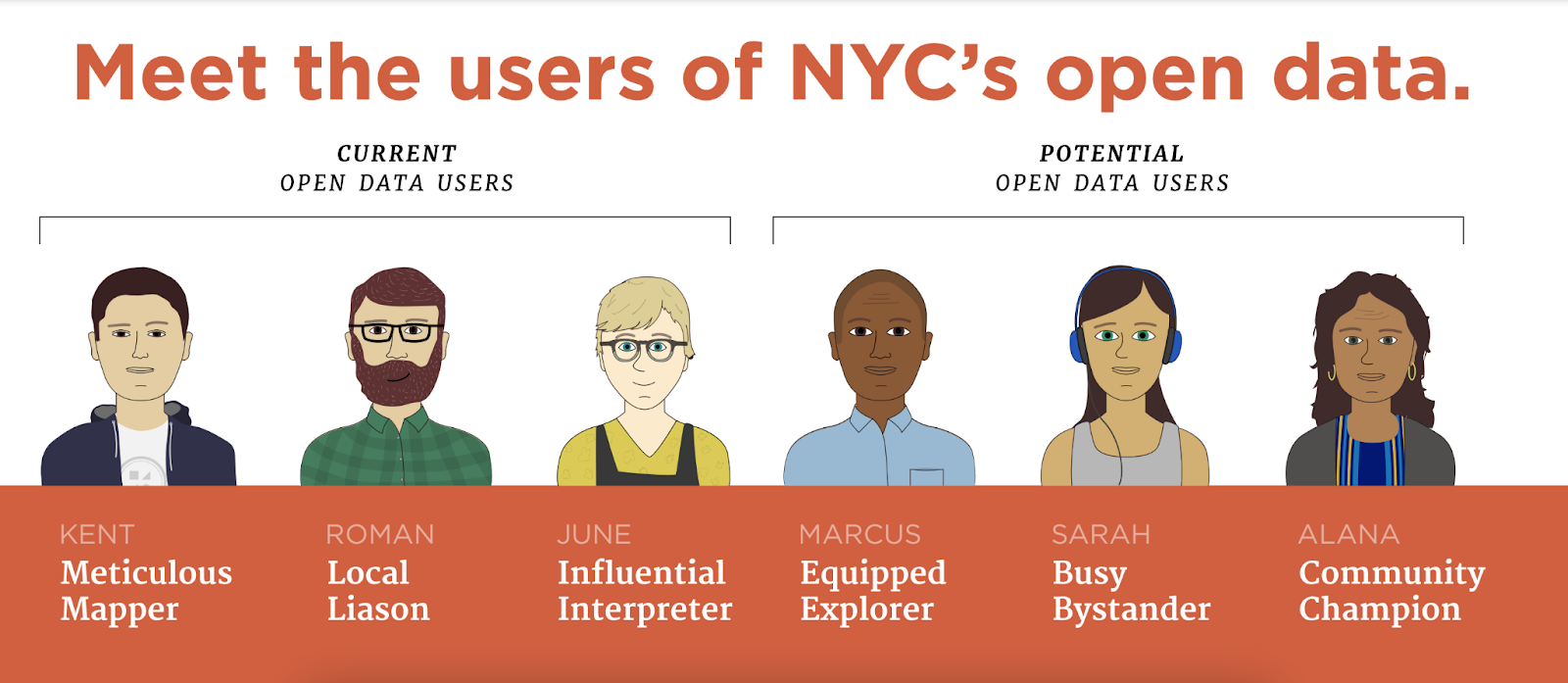
User Personas: Your Guide to Building Personas for UX
Looking to learn more about creating user personas? Look no further—read on to find everything you need to know about building user personas and turning them into key assets for your UX team, from persona mapping to creating your own user personas using templates.
Chapter 1
Getting to know user personas
In this chapter, we dive into user personas and why they’re important for UI and UX design. We’ll also discover what makes a good user persona—from being unique to avoiding bias. Let’s get started.
What is a user persona? (And why it's important to define)
User personas are user profiles that represent the wants and needs of a subgroup of your target audience. These personas are an in-depth analysis of your ideal customer—their behavior patterns, goals, skills, attitudes, problems, and background information.
User personas help you identify key themes and thought patterns amongst your audience, which enable you to connect with target users and make better product and design decisions. Design teams can use this information to build products and services that meet real audience needs.
You likely already know what a user persona is. Here, we want to dive deeper into the practice of creating user personas and share how to make them as useful as possible for your team.
What are the benefits of creating user personas?
User personas ensure you’re building for real people, not assumptions. Here’s how they help:
- You design for your users: Without personas, you might think most of your audience wants a sleek, cutting-edge interface. But what if they actually value simplicity and ease of use over flashy buttons? Understanding their expectations ensures you build something they’ll actually engage with instead of something they’ll abandon out of frustration.
- Your team works together: Ever had a marketing team target one type of user while the product team designs for another? Personas align everyone—designers, developers, marketers, and leadership—around a shared understanding of who you’re building for. This means fewer miscommunications, less wasted effort, and a more cohesive user experience.
- Your messaging resonates (and converts!): Have you ever read an ad and thought “That’s totally me”? That’s the power of personas. They help you craft products and marketing messages that speak directly to what your audience cares about, whether that’s saving time, reducing stress, or feeling more in control. When your audience feels understood, they’re far more likely to engage.
- You avoid expensive missteps: Imagine spending months building a feature you think users will love, only to realize they don’t actually need it. That’s time, money, and effort wasted. Personas help you validate ideas before investing in them, ensuring you focus on what truly makes a difference for your users.
- Your product feels effortless to use: When you design based on real behaviors, motivations, and frustrations, users instinctively know how to navigate and interact with your product without any hand-holding.
What does a user persona look like?
A user persona profile represents a subgroup of your target audience and serves as guidance for making product and marketing decisions. Audience personas humanize your user research and real data, to enable you to create more understandable representations of what your audience wants.
The exact information you include in your personas is very context-specific—it depends on what you’re looking to understand. Some information is always a must, like wants and needs, whereas other information, such as gender and location, can often serve little purpose.
Today, user personas are moving away from relying on demographic data. As we’ll explore later, this information leads UX designers to make generalizations about who someone is, and their needs. Demographic data gives us specific data, but not valuable data.
That’s not to say that demographics are never needed in your user personas—it instead means that you should really consider the value—if any—you’re adding with specific demographics.
Instead, modern user personas should include the following information:
- Goals
- Purpose
- Approach
Modern personas should understand who users are, as well as how they interact with and use your product or service. This gives a deeper understanding of how you can best go about improving your product.

What a user persona shouldn’t look like
In the past, a user persona would typically include information along the lines of:
- A picture
- A name
- Age
- Location
- Job title
- Education level
- Marital status
- Family status
- Pain points/frustrations
- Wants/needs
- Biography
- Personality traits
- Preferred social media channels
Why are demographics outdated in user personas?
Simple. You always want to know how your users are feeling—what their thinking style is and how they are applying that to your product or service. The same goes for pain points and frustrations.
Age, gender, location, and other demographic data have little to do with this and may cause generalizations. They can often be a cause of bias or assumptions within personas—this does little to help (and lots to hinder) the application of your personas.
Developing personas should be done on a case-by-case basis that takes great consideration of user context. For example, when using personas to understand the adoption of a new product feature—is gender really relevant? Or, is it a piece of demographic information that permits implicit bias?
Maze’s Ash Oliver, Brand Experience Designer & Founder of Foster, shared more on this:
“We’re talking about humans evaluating humans, so naturally there’s a lot of opportunity for bias. We come with it. It will be there unless we’re relevant and engaged in addressing it.
One of the ways we confront bias at Maze is we draw out stereotypes for this persona. By naming it and calling it out, we can confront it and identify it further down the line. This enables us to better see if something is a small part of a bigger stereotype. It helps us push past that.”
We asked Ash if there were other ways his team proactively tried to avoid bias.
“We strip out the personified parts of a person. I like ones that use metaphors instead of traditional names. Look for an entirely different name to “Dave the designer” for example, and align your names with your company vision or mission–it’s a useful way to remember the personas, as well.”
Ash stressed the importance of collaboration to help avoid persona bias.
“Working in pairs or collaboratively helps bring more diversity to personas. The more diversity you have within that team, the more lenses you can apply to this information.”
What you include in your user personas—from pictures to gender, age to marital status—decides the assumptions people make when dealing with these personas. This limits the effectiveness of your personas for conveying user needs and wants. We’ll explore more on avoiding bias later in this chapter.
What makes a good user persona?
So, how can you make sure your personas are as useful and informative as possible. First, ditch the idea that the way to build personas is set in stone. There are plenty of ways to go about creating user personas—ways that we’ll develop in chapter two.
For now, let’s consider the characteristics of a good user persona.

User personas are unique
One easy trap you can fall into is plugging new information into past personas.
User personas shouldn’t be copied and pasted from past market research or projects—they need to be unique for each project. By all means, utilize a user persona template to formulate your research—but that’s all it should be: a template.
User personas use real data you've collected and observed
When building your user personas, make sure you’re using real, up-to-date information. You want quantitative information from surveys as much as you want qualitative information from user interviews and real-world customer stories.
Don’t attempt to create personas from data that wasn’t collected for this specific project. You want the buyer persona creation process to start with project-specific user research—that’s the only way you can be sure you’re using relevant research to reflect your target personas.
It’s worth your time and effort to invest the necessary resources into creating an accurate user persona research process.
Building personas 🏗
Jump to learn how to effectively build user personas.
User persona profiles focus on the present
Sure, you’ve got an idea of what you want your customers and target audience to think and feel—but it’s essential to remain realistic with your personas. Ideally, every piece of information you include in your buyer personas should link back to data you’ve collected or observed.
It’s easy to develop personas that are based on stereotypes and expectations, but that’s not beneficial to your product. These types of personas are called proto-personas, and are a big no-no in UX/UI design. You want a realistic character that represents your target audience as they are, not as you wish them to be.
User personas are context-specific
This can often dictate the success of your personas. You want your user personas to include information that’s relevant to the particular context in which they’re applied. We touched upon this when discussing the relevance of certain demographic characteristics that are frequently used in user personas.
You want to make sure you’re including information that’s relevant to your product and project. Your buyer persona needs to focus on the context-specific behaviors and goals related to your product.
Don’t include information for the sake of including it—make sure it’s relevant and specific.
The best personas are created through research, a combination of data and educated guesses.

Ash Oliver
Brand Experience Designer & Founder at Foster
Share
User personas avoid biases
A good user persona aims to avoid biases in creation and distribution. It’s easy to jump to conclusions when interpreting personas, but those conclusions are often rooted in pre-judgment and bias.
One way to avoid implicit bias when it comes to building buyer personas is to only include information that causes behavior or thinking.
You want to understand the reasoning, reaction, and guiding principles of your audience, not superficial demographics that mean little upon closer inspection. This not only helps develop deeper, more meaningful buyer personas, but it also helps mitigate any bias when it comes to using personas throughout your business.
For example, user personas often contain a photo and a name to ensure they’re memorable—this is traditionally an essential part of personas: they must stick in your team’s minds.
This has previously meant a smiling picture accompanied by a descriptive name—like ‘Mary the Mom’—but memorable doesn’t need to mean mundane. Choosing pictures and names your team is familiar with can leave the design process open to bias—there are ample preconceptions about being a mom.
Instead, why not challenge the preconceptions and biases associated with your users? Here’s an example from the user personas developed for the UK Ministry of Justice:
These five personas—Zeus, Icarus, Achilles, Prometheus, and Hades— aim to limit bias and mitigate stigma when it comes to discussing solutions for people in prison. They’re memorable in a different way—and they limit bias in an environment where preconceptions run rife.
Personas in UX design: What are they for?
Now you know what a persona is and what makes one great, let’s take a look at why exactly they’re key for UX teams.
1. Making product decisions
User personas help shape product strategy and enable teams to prioritize features and solutions. Alongside other forms of user and product research, such as usability testing and customer surveys, user personas help create a user-centered point-of-view to inform product decisions and direction.
Let’s say you�’ve got a variety of features that you can and will implement at some point. They’re features you’ve identified as important through research methods, but you’re still a little unsure of where to start.
By considering your user personas, you can see what changes will make the biggest impact on the most users. There are likely areas of your product that more than one persona is interested in, so maybe it’s those areas that you want to target and prioritize. UX designers need to know what the end-user wants—personas help communicate this effectively and minimize speculation. Ash
Oliver, Brand Experience Designer and Founder at Foster, said:
“I think about personas as a composite sketch; a key segment within your users. There’s a variety of different personas, for sales, marketing, product–and even different types of personas within those fields. They’re a framework so you can create products that resonate and are valuable to users.”
2. Understanding and empathizing with users
It’s very easy as a UX designer to create products in somewhat of a tunnel—without adequately considering the needs and wants of your audience. Personas enable designers to empathize with issues and understand how the issues affect their interactions with the product.
User personas represent real people—they include information on likes, habits, attitudes, pain points, and much more. The descriptive and personal nature of personas allows for deeper empathy and understanding from designers.
For example, which of the following persona example snippets is more likely to evoke empathy when designing a social media app for seniors:
Green is 55-65 years old and has never used social media. They’ve got an iPhone and an iPad to browse the web. They don’t know how to send images from one device to another. They want to have one place to store and share their photos.
Green is a newly retired senior who spends a lot of time at home. They love spending time with family and snapping pictures of their grandkids, but they don’t know how to share the images they take. They’d like to view them on the bigger iPad screen but they’re unsure how to send it from their phone to their tablet. They want to be able to look at pictures of their family on all their devices. Now that they’re retired, they've got way more time and energy to spend on their family.
They both say the same thing, but one user persona profile is purely factual where the other paints a picture for designers to understand. This is key for evoking empathy—you want to create a story around your solid data for your team to understand.
3. Aligning teams
User personas are a great way to communicate user research findings to teams that otherwise have no interaction with the end-user. They’re memorable, digestible, and easy to distribute to the different teams in your organization.
User research teams invest great time and energy into finding and listening to research participants. Communicating these findings with the whole organization is an essential step in building actionable user personas.
For example, let’s say the whole organization is working towards creating and communicating a new feature to users. This new feature is being developed as a result of in-depth user research and emerging user personas.
Each team develops a strategy for how they’ll manage their responsibilities—the product team, the marketing team, the customer success team, etc. Each team needs to make sure their strategy aligns with the rest of the organization to ensure a smooth, accurate development and deployment of the feature.
User personas help guarantee everyone has the same information on the main customer groups—there’s no room for different interpretations or assumptions. Ensuring teams understand the personas is key for their use cases, which in turn highlight the beneficial business implications of collaborative user research.
Keeping teams on track is key, and multiple personas enable teams to be user-centric throughout the entire UX design process—whether that’s product development or a marketing campaign.
3 Real-life user persona examples
Let’s look at three examples of well-defined user personas and how they shape product and marketing decisions.
1. Spotify: Creating data science personas for better product decisions
Spotify, best known for its music streaming, also runs an analytics platform used by their internal data teams at Spotify. The challenge? The term ‘data scientist’ was too broad—some employees analyzed business metrics, while others built machine learning models or data infrastructure. A one-size-fits-all approach wasn’t working.
To solve this, Spotify conducted interviews and analyzed user data to create six distinct personas, each representing different ways employees work with data:
- Paola the Product Strategist: Analyzes data to guide business strategy
- Eli the Extensive Explorer: Conducts research and builds machine learning models
- Ivan the Influencer: Leads and mentors data teams, shaping best practices
- Daryl the Data Viz Artist: Focuses on dashboards and data storytelling
- Sigrid the Systems Engineer: Develops the infrastructure for data analysis
- Dalia the Data Dabbler: Uses data for decision-making but isn’t a specialist
These personas became a shared language across Spotify’s internal teams, aligning product decisions with real user needs. Instead of building generic tools, Spotify tailored its analytics platform for each persona’s workflow.
2. Mailchimp: Using user personas to personalize marketing support
Mailchimp, a leading email marketing platform, recognized that small business owners have different working styles and challenges when it comes to marketing. Instead of treating all users the same, they created five playful personas—The Fainting Goat, The Juggler, The Toe Dipper, The Cannonballer, and The Eagle Eye—to reflect different business personalities and marketing approaches.
Each persona represents a unique way business owners engage with marketing—some freeze up when faced with big tasks (Fainting Goat), others juggle too many responsibilities (Juggler), and some dive in headfirst without a plan (Cannonballer).
Mailchimp uses these personas to recommend tailored services and partner support, ensuring users get the right level of guidance and expertise based on their working style.
3. New York City Open Data: Expanding access with user personas
The New York City Mayor’s Office of Data Analytics (MODA) developed user personas as part of its “Open Data for All” initiative, aiming to make public data more accessible and useful to a wider range of residents. Partnering with civic design firm Reboot, they set out to understand who was using NYC’s Open Data portal—and who wasn’t, but could benefit from it.
Through interviews and behavioral research, they created personas representing both current users (like researchers and developers) and potential users (such as community organizers and local business owners).
These personas helped MODA identify barriers preventing broader public engagement, such as lack of technical expertise, confusing interfaces, or uncertainty about how open data could be applied in everyday life.
Next up: How to create user personas
User personas help teams design better products, align strategies, and create experiences that truly serve their users. When you focus on real behaviors and needs rather than assumptions, personas ensure every decision is user-driven.
To build effective user personas, you’ll need to follow the nine-step process we detail in the next chapter:
- Define your user research plan
- Create questions to help map your personas
- Send out your questions
- Segment your data and map your personas
- Clarify how many personas you need
- Find or create a persona template that fits your needs
- Create your personas
- Prioritize your personas
- Name and distribute your personas
We’re ready when you are—see you in Chapter Two.
Frequently asked questions about user personas
What is a user persona?
What is a user persona?
A user persona is a profile that represents a subgroup of your target audience. User personas are based on real-life data and reflect the wants and needs of your target audience.
Why are user personas important?
Why are user personas important?
User personas are important because they help:
- Make informed product decisions
- Empathize with user experiences and needs
- Align different teams
They’re an essential tool for businesses looking to make better, more informed decisions when designing products.
What is the difference between a user and a persona?
What is the difference between a user and a persona?
The difference between a user and a persona is that a user is a real-life customer, and a persona is a representation of a larger group of potential customers. Your user personas should reflect the wants and needs of your users.
How do you identify personas?
How do you identify personas?
You identify personas through user research such as user interviews, surveys, behavioral analytics, and more. You then create user personas to reflect the real-life wants and needs of your target audience.




